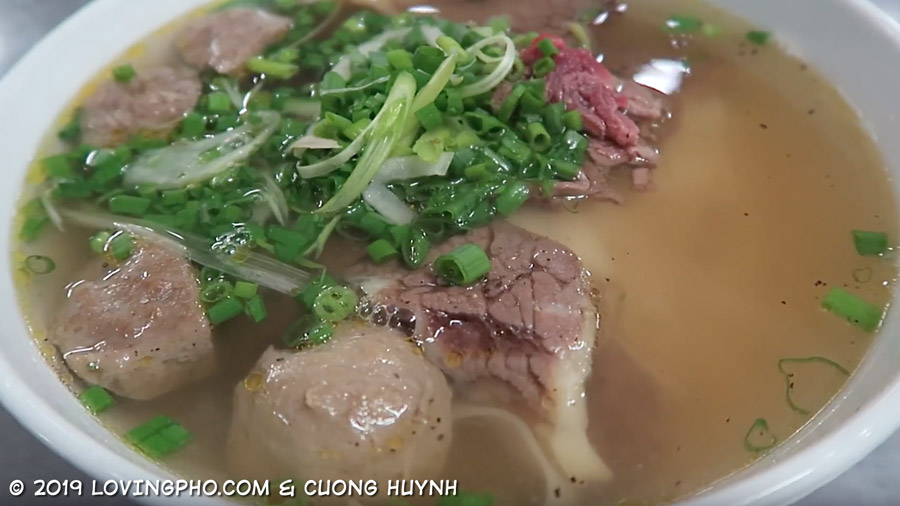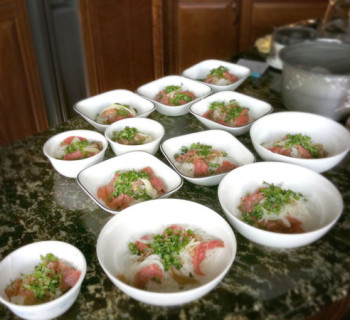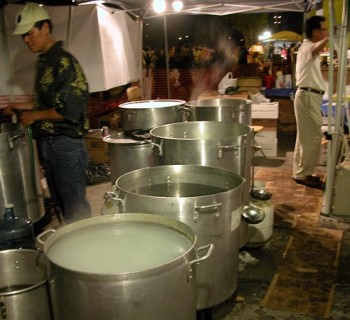 Pho broth is not something you make one portion at a time. You usually make a whole big pot of it.
Pho broth is not something you make one portion at a time. You usually make a whole big pot of it.
For those who make pho at home, a common challenge is they always have more pho broth than they can eat in one sitting/meal, even when having a large group of family and friends over.
So what do you do with the extra broth?
What's the best way to store it?
And what's the best way to reheat to enjoy it again?
Here are some of my recommendations. Where appropriate, I've also provided notes on the differences between serving at home versus in restaurants.
- Assuming that you eat the first pho meal right after you finish cooking, I would suggest portioning the remaining broth into 2 or more portions: one group for the fridge/cooler, the other for the freezer. The number of portions is determined by your container sizes and cooler and freezer spaces.
- Portioning for the cooler (short-term storage) and freezer (long-term storage) should occur preferably within 3-4 hours of end of cooking process.
Note: This is ok for homemade meals; actually anything goes with homemade meals. On the other hand, for restaurants or public service, North American health departments require cooling/freezing within 2-3 hours. Furthermore, when placing containers into storage (either cooler or freezer), restaurants need to properly label everything then follow FIFO (first in, first out) procedures. - You should consume the cooled portions within 6-7 days. Frozen portions can be kept up to several months or longer if you want.
Note: For restaurants I'd recommend more stringent process to ensure quality and to meet regulations. - To prepare cooled broth for a new meal, just heat in a pan or pot, bring to boil, adjust for taste (adding water and/or spices, fish sauce, others, etc.), then serve.
- To prepare frozen broth for a new meal, if you have time, either thaw it first in the fridge/cooler or leave it out on the counter. The former saves the most energy as the thawing broth helps keep the cooler cool, and the latter is less safe. If you're in a hurry to serve your pho, then the most common methods are 1) running under cold water, 2) thawing in the microwave oven, or 3) running under warm/hot water. The first two ways are safe; the third is less safe. All of these are acceptable for home pho. But for restaurants you need to follow the more stringent rules or your local health regulations.
- Under no circumstance that you should endlessly reboiling or maintaining heat on the broth just to keep from having to store in either color or freezer. Aside from very poor cooking technique/practice issues (who would do this to their own meals), endlessly reboiling/reheating doesn't meet the food safety requirement, while at the same time changes the broth's taste profile and the quality goes down fast.
As noted, for home cooked meals, pretty much anything goes because the health department won't ever be pounding on your door and post a health grade on your window.
But if you follow the steps discussed, you will be able to make large portions of pho broth, and enjoy the best pho you can have at home anytime you want, knowing that you've followed safe practices.
It should be mentioned again that for restaurants it's a different thing. There are important reasons why stringent regulations are in place and why a pho restaurant operator should have and follow good standards in their operation.
Here's a video clip showing 6 gallons of beef pho broth being poured for storage. It's actually a very small amount for restaurant, but is way more than enough for a single seating for homemade pho. So proper storage is key.
httpvh://www.youtube.com/watch?v=wTcw0WAfIfw
Leave a question in the comment section below.
For help with your pho restaurant, book a one-hour pho restaurant consultation and get your questions answered.




I think these are all excellent points. For restaurants, I would also add that one can prepare small bags of spices and add it during the retherm/reheat process. This way the broth will come out fresh with fragrance of star anise, clove, cardamom, or whatever your recipe calls for in the spices, just like it’s been freshly cooked.
@haleyax87
Thanks for the input about adding spices at the retherm stage. I must say that this article was written with maybe 70% home cooking and 30% restaurant business content mix. For restaurants there are many more things an operator can do in terms of cooking, cooling, storing and rethermalizing for service.
Nice article, though almost all home cooked pho from people I know pretty much get eaten within a few days. They rarely last even a week ! So we never have to worry about freezing anything.
Haha so true! If you have lots of pho at home why would you want to eat anything else?
@hoangdang52I’ll eat pho everyday. Who needs long term storage??
Hi Cuong: From your experience what is the quality difference between serving freshly made pho broth and serving broth that has been frozen and then thawed? Thanks.
@phuriouspho
I haven’t done very large restaurant quantities but my experience is if you do take care of your broth correctly (during cooking, and freeze as soon as it’s acceptably cooled) then it would taste just as good after reheat. Of course this is assuming you make good pho to begin with
@phuriouspho I don’t think you have to worry too much about difference between the two. Best to focus on making the best broth you can, then cool or freeze it as soon as practicable.
From a restaurant perspective, can you share the methods used to bring a broth back to quality after retherm stage? In my own experience, we pack them into individual servings & reheat when order comes in. I find there is a big drop of quality in terms of spice strength & beefy flavors. Also fish sauce flavors dissipate after 2 days of storage. Your input would be great! Thanks
@Gerald T: For restaurant there are many factors that home cooking does not have to deal with. A complete discussion is not practical here so I’ll just address your individual portioning as a point of discussion.
For restaurant operation, the method to retherm cannot be discussed without understanding the whole production process, from inventory to prep, from bulk cooking/production to scheduling to available equipment and tools, and from storage to service. Each step itself is a process with its own timelines, and procedures, training, employee performance and quality must all be maintained within each. It’s not clear why you individually pack pho broth, so here are some feedback based on what you wrote.
If you’re already packing pho broth portions/servings individually and reheat when order comes in, then I would say you may have a built-in inherent problem within your method and not just from the [quality/spice flavor/beef flavor] standpoint. Generally, individual portioning of servings work better with higher value (and lower volume) dishes like high quality fish, high-end steaks, etc. Bulk volume items like pho broth at a lower price points do not generally benefit from individual portioning. There are many disadvantages to individual portioning of pho broth:
Prep, cooking and storage phases:
– Added labor (and time) to cool/portion/store the individual servings.
– Added storage space needed.
– Added materials and equipment to make individual portioning possible.
Service phase:
– Added labor and complexity to unpack/retherm/verify quality before serving.
– Added amount of trash generated and be managed during and after meal rushes.
– It’s ok if you serve 5-10 orders per hour, but if you hit 30+ per hour then you are screwed with the built-in bottleneck.
I should add that there are always at least some additional seasoning, tasting and adjusting that need to be done when the broth comes out of storage for service. This includes adding fresh spices, fish sauce and other final seasonings depending on the recipe. You never want to rely on pho broth that you taste tested days ago (depending on your storage time), then put into the cooler/freezer, and now serve directly to customers without tasting again. That’s not respecting your food, and not respecting your customers. As Chef Ramsay and other pros would ask: “Did you taste your food before serving?”
It makes more sense to retherm pho broth in bulk so you can do your tasting and adjusting in bulk. You really don’t want to deal with individual servings except in rare cases. Not sure what specific problem you are trying to solve, but individual portioning of pho broth presents more problems than it may solve.
Final thoughts on the subject: I encourage you to look at the totality of your operation, understand what the problem is, then install both a good process and a set of equipment/tools that will allow you to achieve your business goals. Don’t mean to sound too critical, but the alternative to pointing out facts is a restaurant’s failure, and we don’t want that. Hope this helps.
I just so happened to stumble onto your site & am so surprised on your quick response! I am very grateful to learn such a detailed perspective! I should have clarified that due to Covid & lock downs, resulted in kitchen staffing & operational changes due to drop in business sales.
Our menu consist of different varieties from noodles, rice to sharing platters. Our noodles currently generates 8% of orders vs 30% pre-covid days. Now, noodle orders are inconsistent & we are unable to gauge how much to prepare. So we decided to prepare individual portioning as a temporary fix just to supplement the low volume of orders. Whilst we focus on pivoting to items that hold better quality in take away formats. But in doing so, the quality of soup flavors has dropped & was looking for solutions.
Our recipe already includes :-
1) beef fat for a boost of fragrance & flavor
New methods we tried were:-
1) adding spice steeped water
2) fish sauce
Result:-
Balancing the flavors was tricky & inconsistent every time. Thus we are still unable to get it back to normal without further added cost of adding beef bones or meats again.
Any ideas would be great to help point us in a better direction! Thank you once again!
@Gerald: I’m glad you clarify your specific situation. I generally do not give just “textbook” generic solutions because each restaurant/owner is different and no 2 restaurants are exactly the same. My previous response had a lot of actionable things if you know how to apply to your situation. If you need further ideas and suggestions then we need to discuss your operation in detail before I will provide any additional actionable suggestions that will solve your problems.
That said, here are some more feedback:
– Beef fat: Not sure what is in your beef fat and how it is prepared and added to your broth, but I really do not recommend using beef fat as a way to “boost” pho fragrance & flavor. If your pho is not already “good” (fragrance and flavor) then adding beef fat is not going to make it “good”. Conversely, if adding “beef fat” makes your pho “good” then it should have been part of your standard recipe and not added as an extra boost.
– Spice steeped water: again not sure how you prepare this “water” and how/when it is added during service, but one sure thing is you’re diluting the broth which forces you to start making more adjustments one bowl at a time. This is no way to serve consistently good pho.
– Fish sauce: adding fish sauce should already be a part of your recipe. To be clear, serving immediately following cooking, or serving from bulk storage requires 2 different (maybe similar, still different) recipes. A recipe needs to be tested and accepted to become the official recipe for each different processes in your restaurant. If you don’t already have it, I think you should have one recipe from your pre-COVID days, and a modified one (that’s been tested and accepted) for the current operation.
One thing for sure: COVID is a big deal and should be treated seriously. It may be here to stay for a while yet. If you think COVID is a temporary problem then you may be in for a temporary problem that will last a very long time. My suggestion to all clients is everyone needs to start (better yet, should have started) rethinking their business model and pivot to a new way of doing business at least for the next year/year and a half, maybe longer. Once COVID somehow has passed, the restaurant industry will have moved on to something unlike pre-COVID days, because COVID itself has already changed customer behaviors and expectations, and how people buy their foods. Those who don’t treat COVID this way will constantly be looking for new temporary fixes for a while.
As an owner of a Pho restaurant (www.pho78colorado.com) we make our broth completely fresh every single morning and we always have extra broth. Due to the fact that we pride ourselves on making it fresh every morning like they do in Vietnam we have to be very carfeul on not making on over abundant amount or else we will be wasting a ton of broth.
@Pho Champion: I applaud your effort to make it fresh everyday. If your volume is low then this may be ok. But for medium to large volumes (100+ bowls per day) as a business decision it may not be wise to continue doing this, as you say you always have extra broth. Since it’s not clear what you meant by “extra broth”, I will assume extra leftover broth at the end of the day. So for one thing, this extra broth, if it has been treated correctly throughout the day, should be stored away for serving the next day. Otherwise if you throw the leftover away then you would have a lot of waste, thus higher food cost than you could have. On the other hand, if you do reuse leftover broth for next day, then this sort of defeat the fresh broth everyday. Maybe I’m missing something, and am curious to find out what your operation is like. Care to clarify?
By the way, one main reason why they have to make fresh broth everyday in VN is due in large part the lack of modern and safe storage of bulk broth. This is especially true for small operations. For larger operations in VN especially those pushing high volumes, they do have large production and storage facilities and do make broth in bulk then store them away. This ensures they always have enough on hand for both regular service and sudden spikes of customers.